
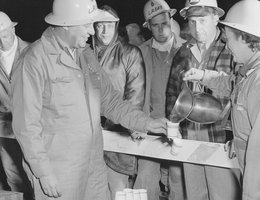
There are very few people who have seen an atomic bomb explode — or who would want to. But in 1955, there were several Nebraskans who were among the 5,800 civilian and military witnesses to an atomic test blast. The civilians were there by choice, while most of the military observers had been ordered there. The experiment was known as Operation Cue.
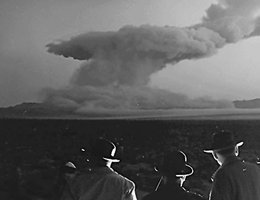
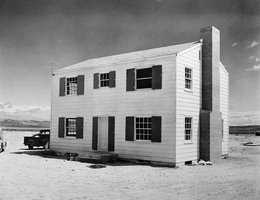
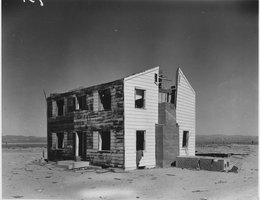
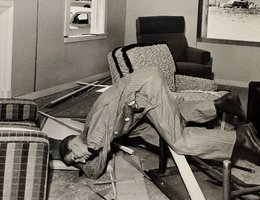
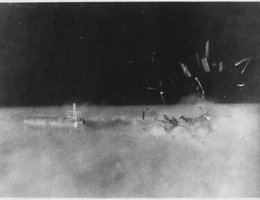
![After blast: line of mannequins [sic] at 7,000 feet, part of thermal radiation test, May 5, 1955](/assets/images/0905_0207mannekins.c2844ca3.fill-260x200-c100.jpg)
Operation Cue was not the first attempt to test the effects an atomic explosion would have on buildings and houses (constructed of different materials) and cars. Nor was it the first to have observers fairly close to the explosion, but it was the first and largest atomic test site that was conducted specifically for civilians. Coverage of the test was carried live, nationwide by radio and TV stations, as well as extended coverage in newspapers.
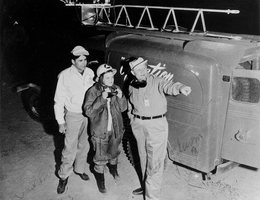
The goal of the test was to see how well houses, shelters, power lines, a radio tower, metal buildings, food, clothing, mannequins (standing in for people) and actual people would survive at various distances away from a nuclear blast.
Among the Nebraskans were former Governor Val Peterson (who was then head of the Federal Civil Defense Administration), local CD official Melba Scott from Lincoln, and brothers Walter, Mike and Gilbert Behlen from Columbus. Special high-speed cameras, developed by Nebraska native Dr. Harold Edgerton, were located throughout the "town" to document the explosion. The Behlens were there to see how well their buildings would hold up to the blast. Melba Scott and Val Peterson were there to learn how to help civilians survive a nuclear war. Peterson spoke to the observers the day before the blast:
"For our friends representing the public media the story will be over in a few days. . . . But for those of us in civil defense, the day the program ends is really the day our work begins. It will then be our job to take back home with us all that we have learned and to make sure that it becomes of lasting value to national civil defense."
For Melba Scott, the experience began as a frustrating one — the test kept getting called off because of high winds at the test site. On the ninth day, the witnesses were all in position and the managers of the test actually started the countdown.
"So we were out there, but they didn’t call it [off], and we kept thinking they were going to and they didn’t. But when they did the countdown, I guess maybe that was the first realization, from the ten — to the nine. . . . I was wearing the goggles and the helmet and the coveralls. . . . I was standing up [about six miles away from the explosion], because the shock wave almost knocked us over — you needed to brace yourself. It was considerable. . . . [Afterward] what I remember is the silence. It was like — it was so awesome. It was so much more than anybody could ever imagine, that you just weren’t able — everybody kind of retreated into themselves. It was so quiet. . . . You just can’t look into the bowels of Hell and not be changed."
The blast was about twice as powerful as the Hiroshima bomb, but hundreds of times less powerful than hydrogen "Superbombs." After the explosion, the troops, who had been stationed in tanks around two miles from the blast and in trenches around three miles away, began simulating military operations. Melba and the other civilian observers went back to the barracks they had been staying in, called "Survival City." They ate lunch — all part of an experiment in what it would take to fly and truck in enough food for thousands of people after an atomic explosion. The restaurant association and private food companies, including Omaha hotel owner E. C. "Gene" Eppley, donated food to the test.
The next day, Melba and the others rehearsed specific assignments to carry out within the blast areas. Melba was with the medical corps that would attend to wounded people in the blast area. Others were in fire units, rescue units and food service. Each group rehearsed what they might do in the event of a real blast. FCDA officials checked on how well the various buildings and mannequins survived.
They found that the blast damaged or destroyed most of the standard buildings in its path out to three miles away from ground zero. But, Melba remembers that the radio towers about two miles away were back on the air within a day or two. And some of the houses survived.
"That brick house survived great. There was some damage, but I’ve seen houses sell here in Lincoln that need more work — that’s my real estate background."
They did not test Melba for radiation exposure before or after the test blast.
"I can’t even find out today from the government how much radiation there would have been at that distance... [But,] I’m still here."
And she came back from the atomic bomb test dedicated to helping civilians survive an atomic war, despite the fact that hydrogen bombs were 250 times more powerful than the Operation Cue device.
The bomb for Operation Cue yielded about 30 kilotons — the equivalent of 30,000 tons of TNT. The first hydrogen bomb had already been tested in 1952. It yielded the equivalent of 10,000,000 tons of TNT or 10 Megatons. While Operation Cue produced a blast area three miles out, the hydrogen bomb blast area extended out 16 miles, and the fallout reached 1,000 miles.
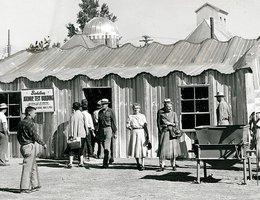
The Behlen buildings were a success story in Operation Cue. Three buildings were built on concrete footings with standard construction at various distances from the blast. At the same distances, two other competing models were built. None of these test buildings were not designed to resist atomic blast.
After the test, they found that the Behlen building at 6,800 feet away from the blast — a little over a mile — was damaged but "all of the pieces remain bolted together and the building still offers good protection from the elements to interior contents." The roof had been bent in about two feet and the windows on the blast side had been shattered, but it held together. The other metal buildings at that distance were destroyed. This dramatic endorsement led Behlen Manufacturing of Columbus to begin marketing a new product — family and community blast and fallout shelters. Later they hired former FCDA administrator Val Peterson as their "Shelter Products Advisor." One of the ways they advertised was to rebuild the actual Operation Cue building at state fairs and other venues so people could see the building that survived the atomic bomb.